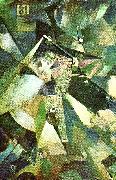Wholesale Oil Painting No Minimum |
|||||||||||
|
|
|||||||||||

|
|||||||||||
|
|
|
||||||||
Kurt SchwittersGerman Dadaist Painter and Sculptor, 1887-1948 German painter, sculptor, designer and writer. He studied at the Kunstakademie in Dresden (1909-14) and served as a clerical officer and mechanical draughtsman during World War I. At first his painting was naturalistic and then Impressionistic, until he came into contact with Expressionist art, particularly the art associated with Der Sturm, in 1918. He painted mystical and apocalyptic landscapes, such as Mountain Graveyard (1912; New York, Guggenheim), and also wrote Expressionist poetry for Der Sturm magazine. He became associated with the DADA movement in Berlin after meeting Hans Arp, Raoul Hausmann, Hannah H?ch and Richard Huelsenbeck, and he began to make collages that he called Merzbilder. These were made from waste materials picked up in the streets and parks of Hannover, and in them he saw the creation of a fragile new beauty out of the ruins of German culture. Similarly he began to compose his poetry from snatches of overheard conversations and randomly derived phrases from newspapers and magazines. His mock-romantic poem An Anna Blume, published in Der Sturm in August 1919, was a popular success in Germany. From this time 'Merz' became the name of Schwitters's one-man movement and philosophy. The word derives from a fragment of the word Kommerz, used in an early assemblage (Merzbild, 1919; destr.; see Elderfield, no. 42), for which Schwitters subsequently gave a number of meanings, the most frequent being that of 'refuse' or 'rejects'. In 1919 he wrote: 'The word Merz denotes essentially the combination, for artistic purposes, of all conceivable materials, and, technically, the principle of the equal distribution of the individual materials .... A perambulator wheel, wire-netting, string and cotton wool are factors having equal rights with paint'; such materials were indeed incorporated in Schwitters's large assemblages and painted collages of this period, for example Construction for Noble Ladies (1919; Los Angeles, CA, Co. Mus. A.; see fig. 1; see also COLLAGE). Schwitters's essential aestheticism and formalism alienated him from the political wing of German Dada led by Huelsenbeck, and he was ridiculed as 'the Caspar David Friedrich of the Dadaist Revolution'. Although his work of this period is full of hints and allusions to contemporary political and cultural conditions, unlike the work of George Grosz or John Heartfield it was not polemical or bitterly satirical. |
||||||||
|
|
||||||||
merzbild einunddreissig
merzbild einunddreissig Painting ID:: 67547 |
1920
se 1920 se |
|||||||
|
CONTACT US |

